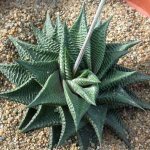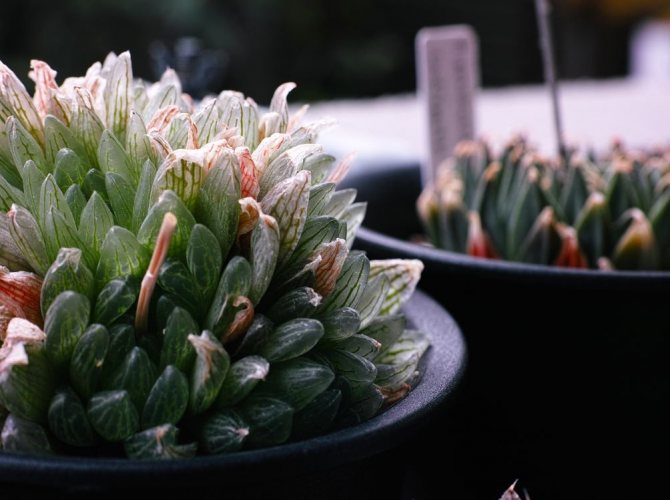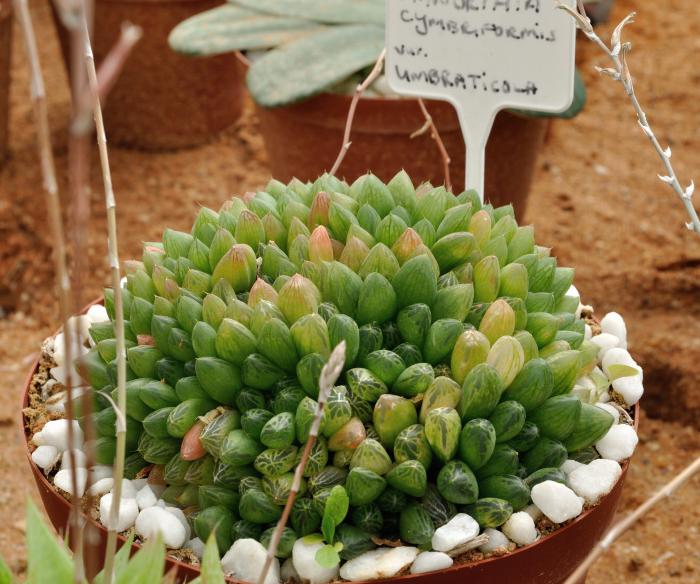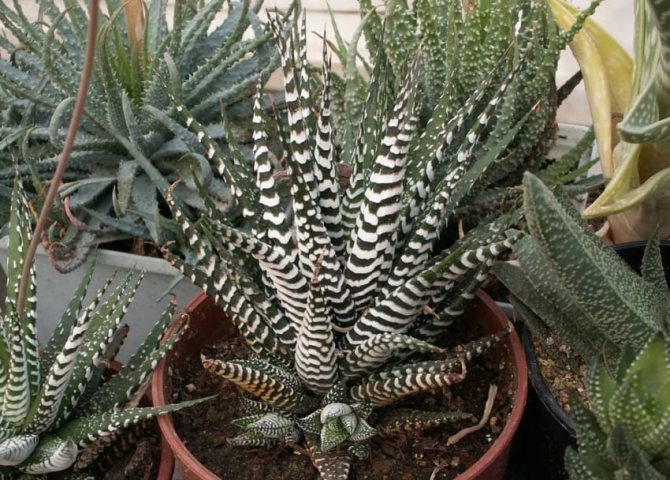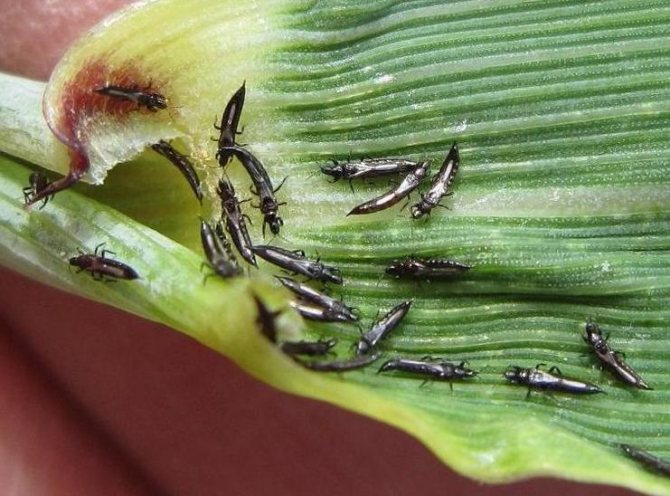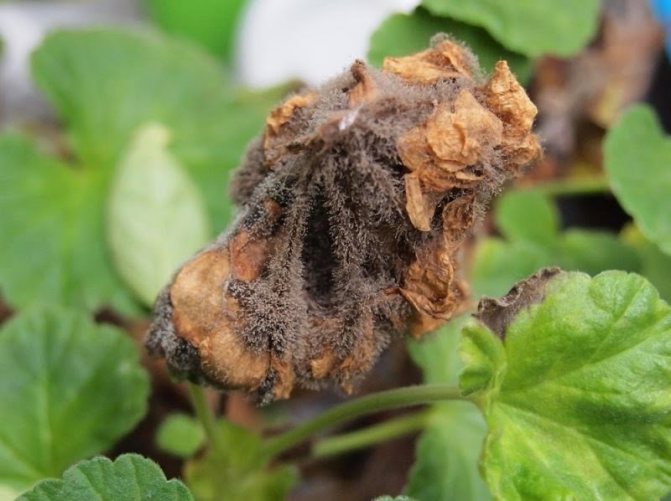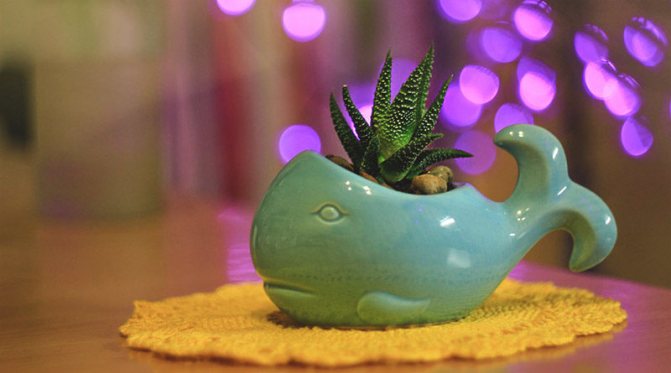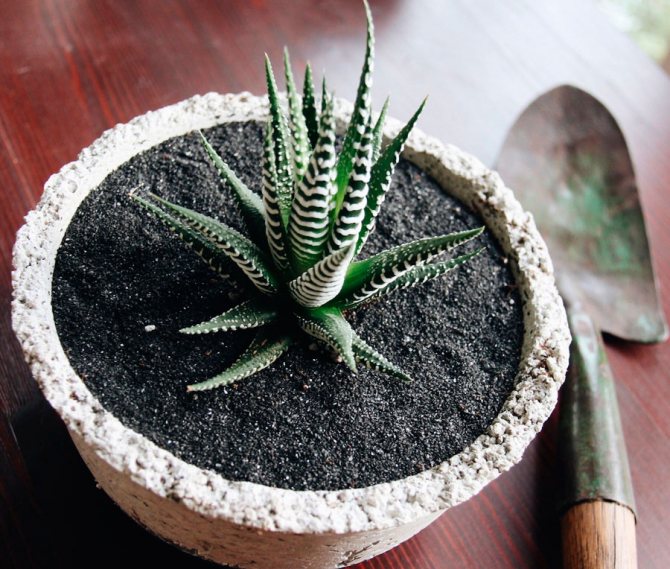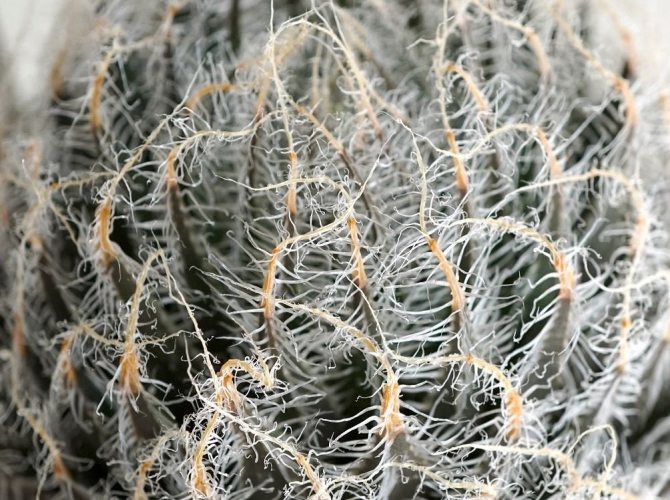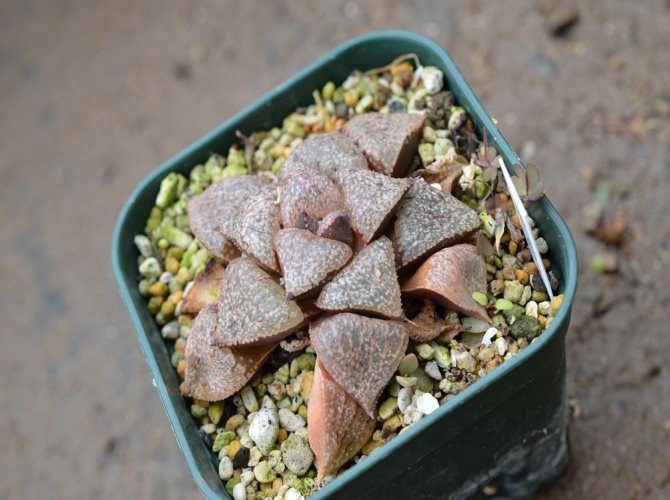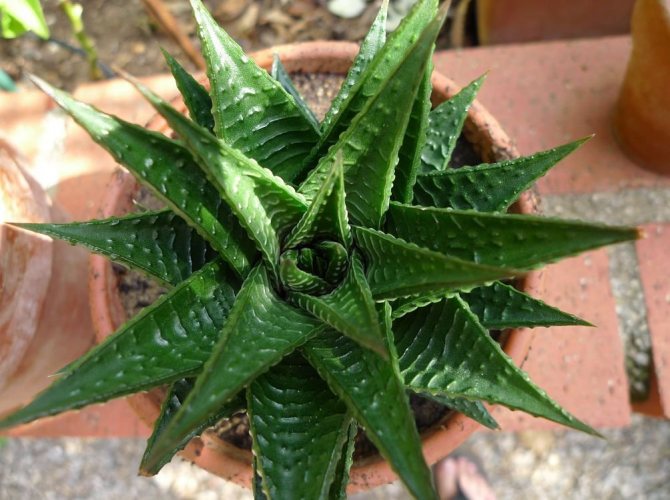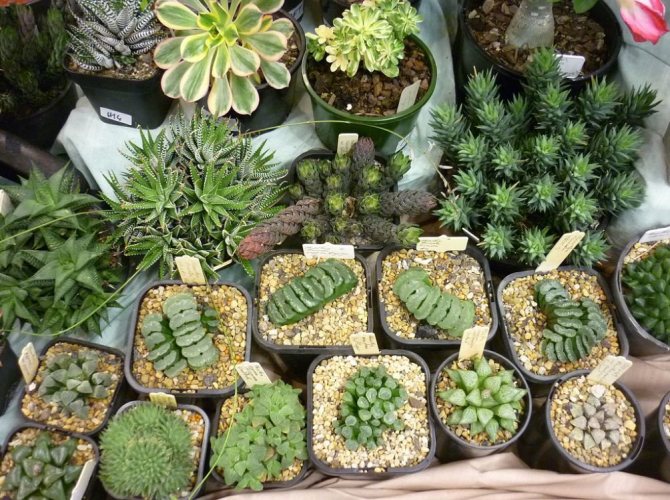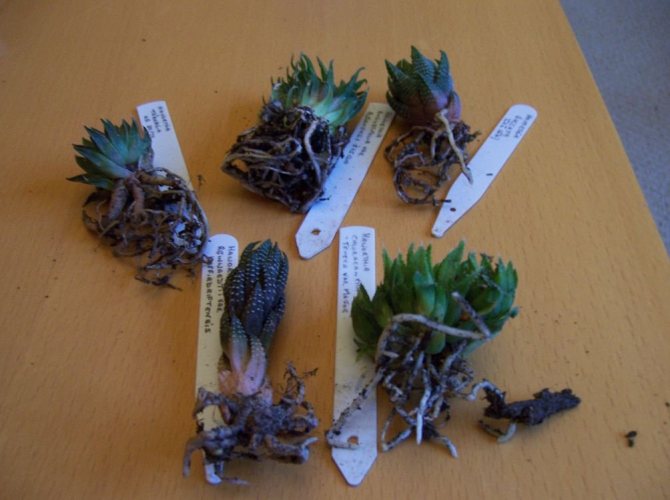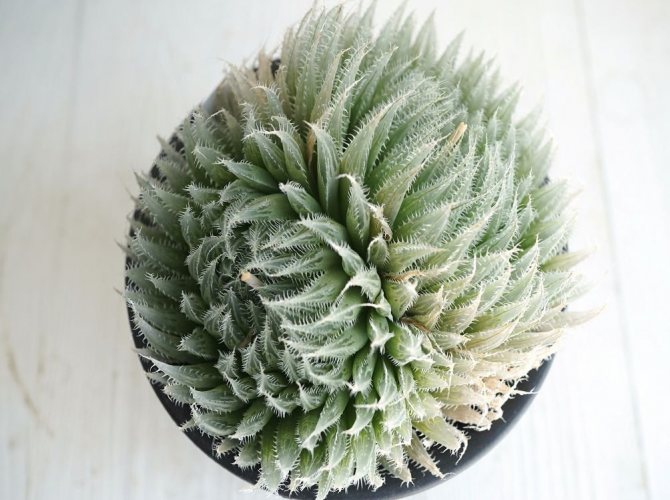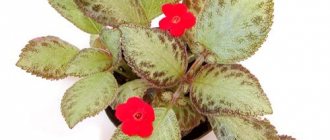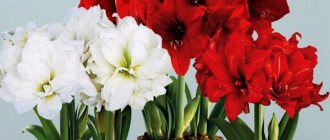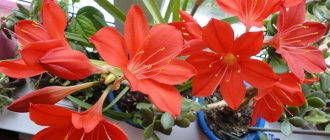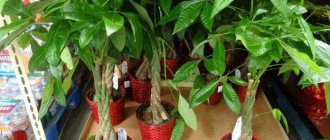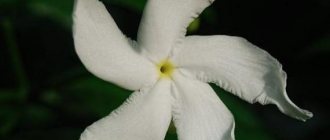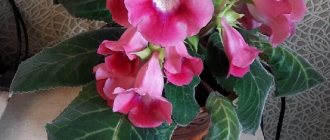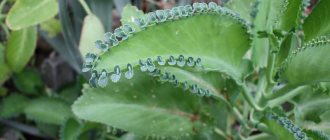Ksantorreev family.
Homeland South Africa. There are about 150 species in nature. This is a fairly common succulent plant, unpretentious and easy to multiply. Haworthia grow on sandy and rocky slopes, under the light cover of taller plants from the scorching rays of the hot sun. These plants have virtually no stem, with the exception of Reinwardt's Haworthia. The leaves form a dense rosette. Long peduncles, from 40 cm in length and above, do not have any decorative value and it is better to cut them off so as not to deplete the plant.
Haworthia pearl Haworthia margaritifera
- fleshy leaves about 7-8 cm long and up to 3 cm wide, collected in a basal rosette, covered with pearl-white warts on both sides, which do not form clear rows. During flowering, a long peduncle with a racemose inflorescence is ejected from the axils of the upper leaves. The flowers are small, nondescript greenish.
Haworthia striped Haworthia fasciata
- very similar to the pearl-bearing haworthia, but its leaves are longer and more sharply pointed at the end. The warts are somewhat smaller, but denser, and cover the underside of the leaves brighter than the top, forming slender rows.
Haworthia reinwardtii
- fleshy leaves, triangular elongated, form an elongated rosette up to 15-20 cm, therefore the stem is first erect, then lodging. On the outer side of the triangular leaf, there are numerous light-colored warts forming transverse or longitudinal rows. The racemose inflorescence is very long, up to 1 m, with inconspicuous yellowish-green flowers.
Haworthia limifolia
- low rare rosettes of fleshy leaves, 4-5 cm long, 2-3 cm wide, on the back of the leaf numerous warts merge into a continuous line, from which the leaf seems to be embossed-striped. Long inflorescence with white small flowers.
Haworthia chess Haworthia tesselata
- very thick and slightly numerical leaves of a triangular shape, finely toothed along the edge, forming small rosettes. The reverse side of the leaf is warty, and the upper side has a pattern of light longitudinal and transverse stripes, similar to a thin mesh.
There are many other species in culture besides those listed here. They, for the most part, have warty growths on the leaves (tubercles, bulges), in some species they are so small and not expressive that the leaf seems just rough to the touch. Some types of haworthia are often confused, for example, Haworthia margaritifera (pearl) and Haworthia reinwardtii (Reinwardt), but haworthia pearl has the largest warts of all haworthia, some are shiny and convex. In addition, in determining the species, the shape of the plant itself matters - the pearl-bearing haworthia forms a wide rosette, the leaves sit loosely, their tips stick out in all directions like hedgehogs. At haworthia Reinwardt - the leaves sit tightly, the plant does not form a rosette, but long shoots, each leaf almost to the middle covers the one above. If there is no collection need to determine the type of haworthia, then this is not important, because the conditions of detention are still the same for all representatives of this genus.
Description of the origin and appearance of Haworthia
Haworthia belongs to herbaceous miniature and dwarf succulent plants. The first specimens of this flower from the subfamily Asphodelovs came to Europe in the 18th century. The homeland of Haworthia is Southwest and South Africa.
The plant got its name in honor of Adrian Haworth, an English botanist and researcher of the flora of Africa.
In nature, Haworthia grows in arid places, preferring to hide under rocks, in the grass or in the shade of bushes. Specimens growing in a desert area in direct sunlight are almost completely hidden under a layer of soil, leaving only the tips of leaves on the surface.
To date, about 150 plant species are known. Many are cultivated in indoor floriculture.
Haworthia is a small plant. It grows in height from 7 to 30 cm. The leaves are fleshy and dense, dark or light green, brown or blue-green. They are collected in rosettes located on a very short stem or at ground level. The leaf surface can be smooth or with white, glaze-like tubercles, which sometimes merge into streaks and streaks. The edge of the leaf plate is also varied - serrated, covered with "cilia", completely smooth, and the tip of the leaf is sharp or smoothed.
Some types of haworthia have an interesting feature. At the tips of their leaves are small transparent areas that look like windows. Through them, light penetrates deep into the tissues of the plant.
The flowers are completely inconspicuous, small in size. The shape is tubular, the petals are bent.
Plant video
Haworthia is often confused with other plants, including spinous aloe. However, experienced flower growers can easily distinguish them - aloe does not form children, while Haworthia has them in abundance. In addition, on the underside of the leaves of the Haworthia, the "rib" is clearly felt, and the upper part of the leaf plate is rough, but the aloe does not possess these features.
Potential problems and pests
The problems that may appear with striped haworthia include the following:
- The roots dry out from waterlogging.
- The bush is clumping due to the fact that it reaches for the light. To avoid this, it is worth turning the pot on the other side.
- Waterlogging can lead to darkening, as well as rot on the leaves.
As for diseases and pests, they can be represented as follows:
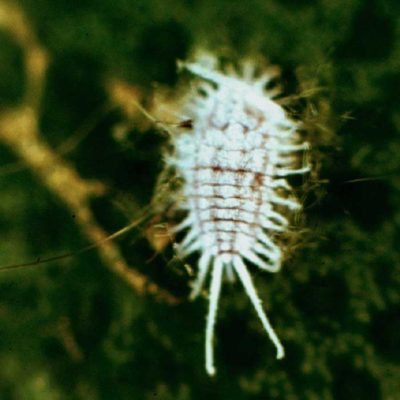
Mealybug... It settles at the bottom of the leaves and forms cellulose-type spots. They are often white in color.
A very effective method of control will be the treatment of the plant with a cotton swab, which must first be moistened with alcohol. This will remove all parasites. But that's not all. To complete the procedure, you need to treat the leaves with soapy water.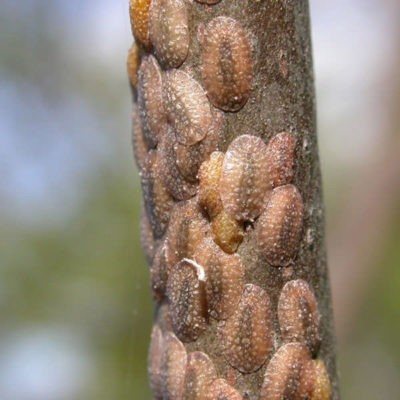

Shield... It often occurs on the underside of the leaves. It looks like yellow spots. A sooty fungus can often settle on the secretions.
The method of struggle will be cleaning the leaves with a brush dipped in a solution of soap or alcohol. If the infestation is too severe, you should treat Haworthia with actellic or carbonic phosphorus.
Planting and transplanting
How do I prepare for the procedure?
The new planting container should be slightly more spacious than the old one. Many growers transplant the plant into the same pot, renewing the soil. Give preference to a round pot, wide, but not high. Too large a volume is undesirable, in it the haworthia will begin to form a large root system to the detriment of the leaves. And in a small container, the roots are not prone to overgrowth. In addition, large volumes lead to acidification of the soil. Drainage holes are a prerequisite in the selection of new containers.
Haworthia does not need particularly nutritious mixtures, as it grows in nature on rocky soils. Succulent soil with neutral or slightly alkaline pH values is suitable for planting. Brick chips added to the mix will help regulate moisture levels. But over time, the crumb disintegrates, which can harm the plant.You can prepare the potting soil yourself. This will require:
- 2 parts river sand;
- 1 part high moor peat;
- 1 part deciduous humus.
You can also take humus and sand in equal proportions. Or prepare a mixture of clay, sand and crushed shell rock.
When should you transplant a flower?
Adult plants are transplanted once every 2-3 years, when the old pot becomes cramped, young plants are transplanted once a year. If the roots die off for any reason, the transplant is carried out immediately - in a small pot.
If you purchased Haworthia from a store, it should be transplanted. The transport soil is not suitable for the plant, and it will not hurt to check the roots.
Step by step process
- Cover the bottom of the planting pot with expanded clay or broken shards to provide the plant with good drainage.
- We carefully examine the Hawortia taken from the old pot. If damage or dry roots are found, we cut them to healthy tissue. We treat the sections with a fungicide and leave to dry for a day.
- We lower the plant into a new container and gradually add the soil mixture. To distribute the earth evenly in the roots, lightly pat the sides of the pot or gently bang it on the surface. Under no circumstances should the earth be rammed. The root system is very fragile. Even if small voids remain in it, this is normal.
- We collect the earth around the planted plant in the form of a cone, so that the water flows down to the walls of the pot when watering.
- If the roots are not cut or damaged, the plant can be slightly moistened. We do not water Haworthia with a damaged root system for a week.
Planting a mix of succulents in an open florarium
Glass vessels of various shapes and sizes are suitable for creating a future masterpiece. In order to create a wonderful garden with your own hands, you need to do the following steps:
- The vessel for the future florarium must be well washed and disinfected by moistening the napkin with alcohol and wiping the inner walls.
- Fill the vessel with a layer of drainage. It will take a lot. This is a prerequisite, since the glass container has no holes.
- Prepare the soil by mixing garden and leaf soil, add sand and activated carbon (it will have an antibacterial effect on the soil and prevent mold from forming).
- Prepare decorative elements: beautiful pebbles, driftwood, shells, colored sand.
- Carefully select plants, future inhabitants of the florarium and think over the composition in advance.
- Clean the soil from the roots, carefully plant the haworthia in the grooves and add decor.
- Pour the composition lightly from the watering can with the nozzle. Carry out the next watering in a month.
- Place the florarium in a bright and well-ventilated area.
Haworthia compressed (Haworthia coarctata)
Occurs on rocky mountain slopes in the Cape Province (South Africa). Plants with a stem 15-20 cm high and up to 8 cm wide, with shoots developing at the base. Leaves forming a dense rosette, spirally arranged, raised upward, curved inward, triangular-lanceolate, elongate pointed, 4-6 cm long and 1.5 cm wide, thick, 0.6 cm thick, dark green, convex below, with indistinct longitudinal lines and unevenly spaced warts.
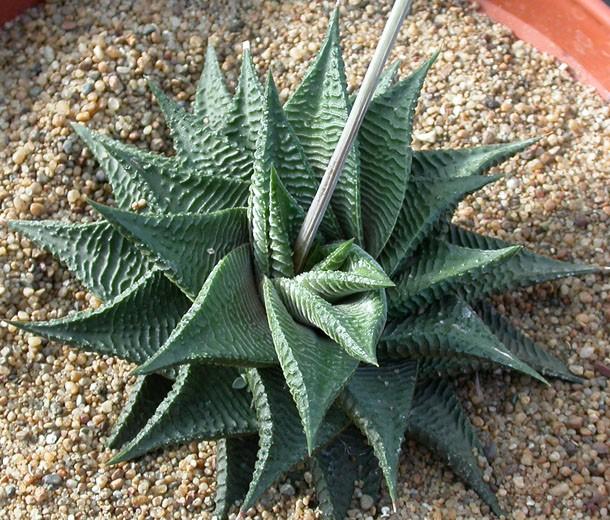

Haworthia terkolistnaya
Plant care
How to water?
Moderate watering is the key to healthy development of Haworthia. In the summer, the plant is moistened 2-3 times a month, it all depends on the temperature conditions. If Haworthia is outdoors in summer, watering should be more abundant and frequent. In the shade, the substrate does not dry out so quickly, so it is moistened a little less often. The next watering can be carried out if the earth is almost completely dry. Winter watering is reduced to 1 time per month. Be sure to drain the water from the sump.
When watering, it is important to observe the only rule - water should not fall on the leaves of the plant.The moisture accumulated in the outlet will destroy the flower.
Top dressing
Fertilizing the plant begins in the spring, and stops with the onset of autumn. Top dressing is carried out once a month with means for cacti and succulents, diluting them with water 2 times more than recommended by the manufacturer. You can use granular fertilizers by adding them to the soil in the amount indicated on the package. An overdose will not happen, because nutrients are released only when the soil is moist, and haworthia is rarely watered.
Many owners of exotic Haworthia would like to accelerate the growth of the flower. This can be done by selecting fertilizers with a high content of phosphorus and potassium and less nitrogen. Nitrogen fertilization will cause the plant to stretch, resulting in loss of compact form and leaf cracking.
Flowering period
At home, Haworthia rarely blooms. Around May, adult plants release long stalks with nondescript flowers. Although there are varieties, for example, Haworthia navicular, with a rather interesting flowering. Experts recommend removing the peduncle immediately after it appears so that the plant does not waste extra energy. In addition, there are species for which flowering is an extremely undesirable process, since the plant dies immediately after it.
An interesting fact, but it turns out that if you take care of the Hawortia correctly, it blooms even less often. But if this happens, you can wait for the plant to bloom and carefully remove the peduncle. Or pollinate a flower to get seeds for planting. But the period of seed ripening takes too much energy from the plant and can cause its death.
Dormant period
The dormant period of Haworthia falls in the winter. It lasts from November to March. At this time, the plant must be moved away from the central heating batteries to a cooler and brighter place with a temperature of + 10 ... + 12 ° С, but not lower than + 5 ° С. It is rarely watered - once a month. Top dressing is not applied.
Errors in care, causes and methods of elimination - table
Lighting.
Haworthia is unpretentious, it can do with almost any corner, except, of course, a completely shaded place. But, it acquires all decorative properties in a well-lit location. Under natural conditions, Haworthia grow in open desert areas, under the daily scorching sun. In indoor conditions, of course, this is not required. It is enough to place an east, west or very light north window (not shaded by trees from the street) on the windowsills. From the middle of autumn, in our latitudes, there is not enough light for the normal development. Therefore, for the winter, it is better to place on the windows with a south orientation.
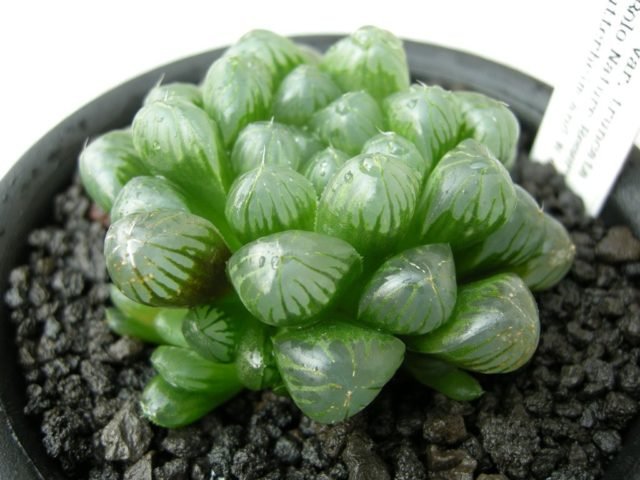

Haworthia cooperi var. truncata
How to propagate a flower?
Seating for children
There are several ways to breed Haworthia. The simplest of them is to plant the children that appear on the mother plant. It is easy to do this in the spring during transplanting:
- Remove the plant from the pot. Shake off the soil carefully. Carefully separate the children together with the root.
- Plant young plants in pots with sterilized soil, water.
If the kids split off without roots, it doesn't matter. Powder the wounds with activated charcoal or sulfur powder and leave to dry for a few days. After that, you can safely plant the plants in wet sand, and after rooting, transplant them into a suitable soil mixture.
Planting a leaf
This is a more interesting option, suitable for species with narrowly elongated leaves.
- Break off an adult haworthia leaf so that it does not break in the middle, but moves away from the place of attachment to the stem. To do this, pull the sheet to the side.
- Dry for a week or two.
- Then, plant the leaf in wet sand. Until roots are formed, no need to water. This will take about a month.
There is no need to build greenhouses, otherwise the leaf may rot. The best time for rooting is from February to March.
Rooting stem cutting
- The stalk is separated with a sharp knife or strong silk thread, placing it above the lower sheets. Using a stick, straighten the thread so that it tightly wraps around the stem, cross it and with one sharp movement separate the cutting from the plant.
- Treat the cut site with sulfur, activated carbon or fungicide. Dry for a week.
- The cutting takes root in wet sand.
- After the root system appears, transplant the haworthia into permanent soil.
Sowing seeds
This method is more complicated. More suitable for breeders, since the process is very long and the seeds do not always germinate.
- Press the seeds lightly into wet sand or a mixture of vermiculite, perlite, coarse sand and succulent soil mixture. Cover the container with glass or foil. Maintain the temperature at the level of + 20 ... + 25 ° С until the emergence of shoots.
- The place should be well lit. When the first shoots appear, place the pot under artificial lighting, remove the film or glass.
- After about six months, dive the seedlings into separate pots.
Haworthia retusa
In nature, forms dense clusters of large outlets. The leaves are dull at the ends The color of the leaves is from green to brick-red.
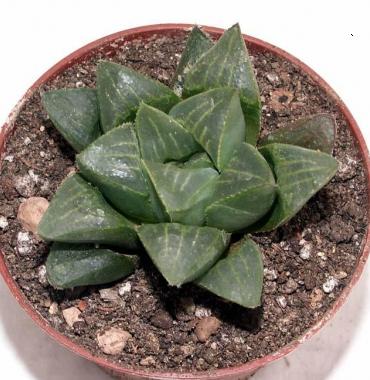

Haworthia blunted
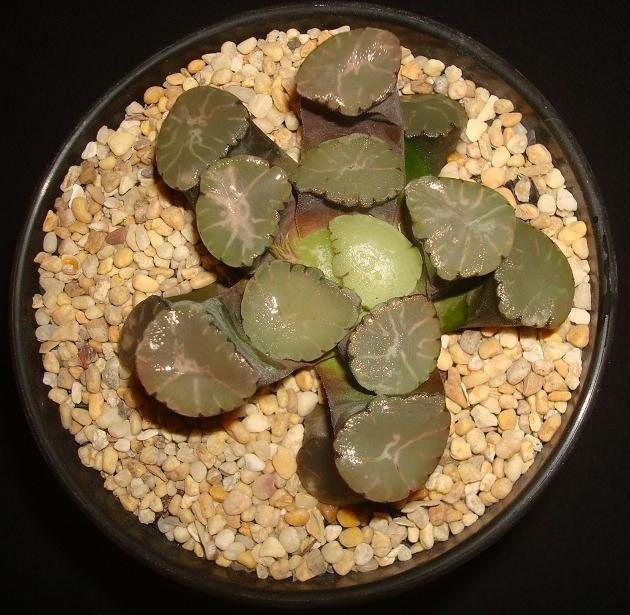

H. Maugana
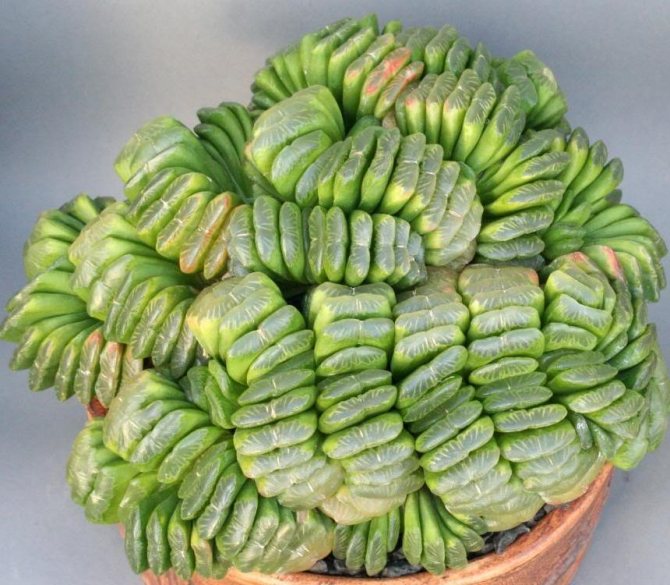

H. cropped
Florist reviews
Children of this flower were given to me by my mother several times. By the way, the plant reproduces very quickly. But our relationship did not work out, since I did not comply with the main condition for leaving - I flooded the poor things. And to treat haworthia should be roughly like a cactus (succulent). Here is the basic rule - moderate watering both in winter (once a month is enough) and in summer. The rest is a very unpretentious and beautiful plant. Based on my mom's experience, you shouldn't bother too much. The plant can bloom and multiply without unnecessary care. Flowers appear on a long arrow growing from a central rosette. Small, delicate and very beautiful!
Hooligan
I bought my havortia with a small rosette from a succulent mix almost 4 years ago. For about a year, she lived with me in a succulent composition in a bowl, not adding in growth and not growing roots. But when I moved to a new apartment and transplanted her into a separate pot, she briskly started to grow and began to grow new sockets. I still cannot understand why the climate here suits her better, I keep it in the same conditions: a western window, succulent earth mixed with coarse sand, rare watering (after the earth has completely dried out). In general, the plant is cute, unpretentious, ideal for those who like to travel, leaving the plants without watering for a couple of weeks.
DDarya
I had a haworthia about four years ago, a friend gave me a sprout. The plant was planted in a pot that was relatively large for him at that time, it took root without problems. During this time, it has never been transplanted and never fed with fertilizers. Every spring I take my haworthia out into the street, where she lives until late autumn. In summer, it releases arrows with small white flowers. I water it in the summer almost every day, and in the winter, watering is minimized, about once a month. It grows quickly and looks impressive.
Krisha
Haworthia is suitable for those who sometimes forget to water the flowers, because it comes from arid countries and can keep water in the stem and leaves for a long time. Beautiful, juicy green, rough leaves bribed me with their beauty. On the kitchen windowsill, in the area of direct sunlight, the plant began to wither quickly, and the leaves began to rot and fall off. After transplanting into another flower pot, for cacti, I left it in the bathroom on the washing machine. And what do you think? Juicy greens, new shoots just filled the pot, I had to plant it. Apparently, I really liked the vibration of the washing machine or something else.Now I just sometimes forget to turn off the light in the bathroom, where now is my little arboretum from Haworthia.
Gardekja
Haworthia fascinates more and more lovers of exotic plants with its unpretentiousness and undemandingness. In addition to its amazing appearance, the flower also has useful qualities - by releasing biologically active substances, it has a positive effect on the air in the apartment. With proper care, Haworthia will surely decorate your home and will delight you for years to come.
Where and how to plant?
Succulents are unpretentious plants (this is due to the harsh conditions of the natural environment in which they grow). And Haworthia was no exception. But to get the best result and condition of the plant, it is necessary to care for it. There are certain recommendations on it, following which will help you grow a healthy, long-lived, original and amazingly beautiful plant at home.
Lighting and location
Since in nature the plant prefers to keep in the shade of stones or rare bushes, then at home it must be kept either in partial shade, or under bright, but diffused sunlight.
Cooper likes abundant lighting, but does not tolerate direct sunlight. Thus, the best solution would be to place the succulent near the west, east or south window of the house, and being near the north window can negatively affect the condition of the plant.
Soil requirements
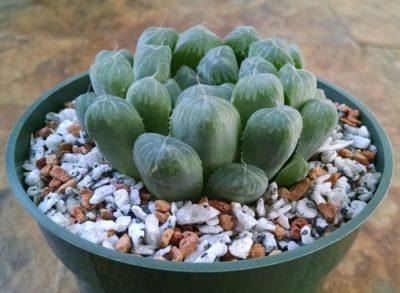

Soil with ph <6 (non-acidic) environment is considered acceptable for Haworthia.
It takes root well in ready-made mixtures for succulents with the addition of clay or special mixtures for Haworthia. Homemade substrates of sand, peat, humus, turf and brick chips in equal proportions are also perfect.
Brick chips are required to prevent decay of the roots and stem of the plant. The content of organic matter in the soil and its air permeability are very important.
Photos of popular types of indoor plants - Haworthia
There are varieties of haworthia:
- hard-leaved;
- herbaceous;
- window.
With tough leaves
The shape of the foliage of the Haworthia is a cone or triangle, the color of the leaves of the succulent is dark green, there are specks. In a group:
- Haworthia drawn;
- haworthia striped;
- haworthia sticky;
- Haworthia Reinwardt;
- haworthia pearl.
On each side of the leaves of the succulent are growths. The foliage color of the haworthia drawn is dark green, the shape is elongated.
In the striped variety, the wart is only on the bottom of the leaf. The upper surface of the plate is smooth. The rough leaves of the sticky Haworthia are arranged in three rows. Below - scaphoid surface, on top - depressed.
More than a hundred varieties are known in total. The most popular types of haworthia: Reinwardt, pearl, striped.
Striped haworthia
The striped Haworthia has no trunk. Thick, narrow, dark green leaves are collected in a dense rosette. White growths form pimples on the lower surface, the upper surface of the leaf is smooth. Small flowers are collected in a panicle. The plant looks like a small aloe.
Haworthia Reinwardt
The succulent grows up to 15 cm. There is no root rosette. Pointed leaves are dense, triangular in shape, curved inward. Above - smooth, below - with dotted bright white growths. Blotches disappear when there is a lack of light. The flowers are yellow-green, clustered in a raceme on a long peduncle.
Pearl Haworthia
Oval dense succulent leaves are pointed. Large pearl specks on both sides. There are thorns along the edges of the leaves. Greenish flowers are collected in a brush. Haworthia pearl lives from five to twenty years. The rosette dies after flowering. It is replaced by new subsidiaries.
Herbaceous
Triangular succulent leaves with cilia are collected in a stemless rosette. In a group:
- haworthia herbaceous;
- haworthia spiderweb;
- haworthia net.
The rosette of the herbaceous variety is formed by small leaves. The color of the foliage determines the degree of light and watering. It varies from light green to deep dark, almost black. The dimensions of the socket are up to 5 cm.
Long cilia at the edges of the cobweb haworthia leaves entwine the plant. Hence the name.
On the yellowish-green surface of the leaves of the reticulated succulent, dark veins are formed that fold into a mesh pattern.
Window
The flowers have translucent "windows" at the ends of the leaves. Succulents are half submerged in the soil, "windows" provide light to the inner parts of the plant.
The shape of the leaves is varied, the color is light green or brown. In terms of properties, window haworthia resemble lithops.
The group includes:
- havortia navicular;
- blunt haworthia;
- havortia chopped off.
The leaves of the scaphoid haworthia are fleshy, gray-green. There are transparent stripes around the ends.
New outlets form quickly. Flowering - several times a year. The flowers are miniature, whitish.
The curved translucent foliage edges of the blunt haworthia are turned back. The single rosettes are fleshy and firm.
Chopped off Haworthias grow vertically. On the surface are the tips of translucent leaves.
Haworthia attenuata
Other names and subspecies: Haworthia attenuata, Haworthia attenuata variegata, Haworthia attenuata f. caespitosis, Haworthia attenuata var. pleased. Rosette plant gradually forming a group. Leaves are dark green, elongated, hard, straight, up to 4-5 cm in length and 1 cm in diameter at the base. Covered with white speck. Less commonly, greenish warts located in lines, of which the lower ones are larger (up to 1 mm in diameter), closely spaced in a row, almost merging. There are many forms. Variety (N. attenuate var. Clariperle) - leaves with large warts on both sides. Highly decorative form.
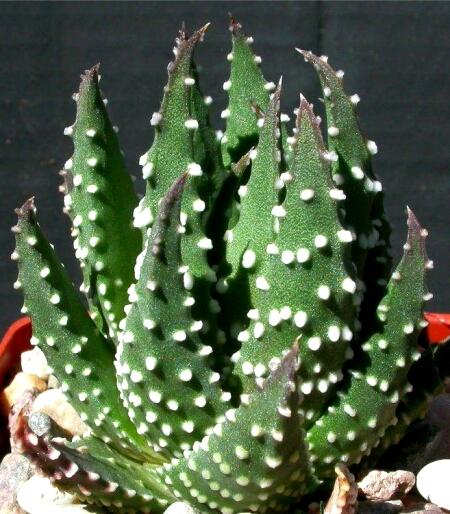

Haworthia pearl
How to properly care for a haworthia indoor flower?
At home, care is the same for all types of haworthia. Indoor plant grows well and multiplies.
Indoor plant lighting
They place the Hawortia in a bright place, inaccessible to the direct rays of the sun. The best places for haworthia are the west and east windows. When placed on the south side, shading is required, and the lack of light on the north side causes a loss of brightness in the color of the leaves.
Dormant period
Winter is a dormant period. The plant is transferred to a cool place away from the heating system with adequate lighting. At uncomfortable temperatures, the leaves darken and rot.
From the balcony or veranda, the pot is brought into the room at night from the end of summer. With the beginning of autumn, the plant stays at home constantly.
Watering
Watering is moderate. From spring to autumn - no more than twice a week, in winter:
- at a temperature of 10-12 ° C every 30 days;
- at a temperature of 13-15 ° C every 21 days;
- at a temperature of 18-20 ° C every 14 days.
The soil surface of the succulent is slightly moistened: the top layer of the Haworthia substrate should dry out by a third between waterings. With excess moisture, root rot is possible.
Water should not get into the center of the bush so that the root rosette does not rot. In summer, water should not remain in the sump.
Humidity
The moisture does not affect the growth of the flower. Spraying is not required. In the summer, the container with the havortia is taken out to the balcony or garden.
Top dressing
From the beginning of spring to the end of summer, the plant is fed. Use a weak solution of special fertilizers for succulents or for ornamental plants once a month. With an excess of nutrients, the leaves change color.
How to transplant Hawortia correctly
Young haworthia plants of any species are transplanted and renewed every two to three years, when the pot is small. Adult specimens - every two years. If the roots die off during the dormant period, replanting must be done immediately.
What pot is needed for a plant
The capacity is needed wide, low, shallow. In pots that are too large, the Haworthia grows in depth, not upward. Too tight a pot is the reason for the shallowness of young leaves.
At home, for the care of haworthia, the best pot is a plastic round. The square roots bend and rot.
The soil
Good soil drainage is essential. Land - an equal amount of clay-sod soil, sand and leafy soil. You can use pieces of lava and pumice stone, adding a little soil to them.
Succulent grows well in a mixture of clay, sand and battered shell rock. The soil needs to be slightly alkaline or neutral. In acidic soil, the plant dies.
Brick chips regulate the moisture well in the pot. But its disintegration into small components worsens the structure of the substrate and harms the flower. It has to be replanted annually.
How to propagate haworthia
The best time to breed Haworthia is spring. Breeding methods:
- kids: during the transplant, the children who have taken root are planted in separate pots. A daughter root rosette without roots is planted in a moist substrate before rooting.
- seeds: It is more difficult to propagate Haworthia by seed. It takes a long time from planting to sprouting. This method is suitable for breeders and lovers of rare types of home flowers.
- leaves: from the mother bush, you can cut off or break off the leaf. It is left to dry for two days, planted in loose soil, soil slightly moistened with water, or a sandy substrate. Do not water the plant for a month. During this time, the leaf gives roots. The seedling is not watered for three weeks. During this time, the first roots appear.
Optimum temperature for growing
The optimum temperature for a flower is 15-20 ° C in summer. In winter - 10-12 ° C. At a lower temperature, the plant dies.
Haworthia navicular (Haworthia cymbiformis)
Description. The stem of the plant is short. The leaves are thick, obovate, concave at the base, pointed, bluish-green in color, 4-5 cm long and 10-12 mm wide, collected in a dense basal rosette 8-10 cm in diameter. Forms a large number of leaf rosettes. At home, it grows almost covered with sandy soil, only parts of the leaves with "windows" protrude outward, letting in the sun's rays. Pedicels are long, flowers are small, whitish. It blooms several times throughout the year. The following varieties are distinguished: Haworthia cymbiformis var. cymbiformis, Haworthia cymbiformis var. incurvula, Haworthia cymbiformis var. obtusa, Haworthia cymbiformis var. obtusa, Haworthia cymbiformis var. reddii, Haworthia cymbiformis var. setulifera, Haworthia cymbiformis var. setulifera.
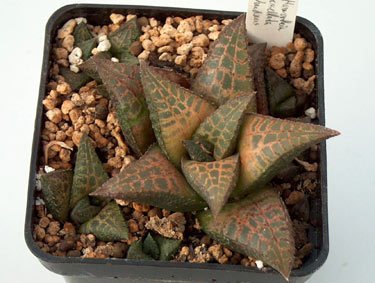

Haworthia mosaic
Difficulties of keeping Haworthia
If Haworthia is grown in composition with other plants, it is placed at the base of larger ones.
Elongation of leaves when caring for home haworthia, looseness and elongation of the outlet - a lack of light. The plant must be transferred to the west or east window.
The leaves are elongated, the edges are bent, the growths fade - the temperature is too high in winter. It is necessary to lower the temperature to 10 ° C ..
During the rest period, the ends of the leaves dry, curl around the edges - excess heat and dryness. The plant needs to be protected from hot air. Glass or placing the pot in a tray with wet pebbles will help.
The flower changes shape, stretches in length - transplantation and feeding are needed. Be sure to separate the kids. When brown spots appear on the leaves, shade the plant.
An interesting property of Haworthia is the need for light for 3-4 hours. Sun training begins in spring gradually, in order to avoid burns.
The lower leaves come off easily, lethargic - the plant is flooded. It is necessary to stop watering until the plant is fully restored.
The color of the leaves changed to pale, yellow, red - an excess of fertilizers. Feeding can be done once a month; fertilizing with fertilizers with a high nitrogen content is unacceptable.
The foliage turns black and rots - the soil is too wet, the temperature and air are very low. The plant is urgently brought into the house.
Photo
Check out the photo of the plant:
Basic rules of agricultural technology
- Haworthia should be in a bright, cool place. A window or glazed winter loggia with a temperature of no more than + 8 + 10 ° C will do. It is necessary to shade from direct sunlight on the flower.
- During the period of active growth from May to October, the flower should be regularly watered with settled water at room temperature. During the rest period, watering is reduced to 1 time per month.
- Also, during the growth period, the flower needs to be fed with complex fertilizers for succulents - once a month. No feeding is needed in winter.
- Transplant an adult plant no more than once every 2 years.
- It is better to propagate haworthia using side outlets or shoots. Before planting, the seedlings must be dried.
Pot and soil selection
There are several soil mix options available for growing these compact succulents:
- Substrate without earth
Many growers prefer to grow their pets in a landless substrate, which is based on perlite, tuff, vermiculite or zeolite. In this case, any of the listed materials is mixed with the same amount of fine gravel, and then the composition is washed from dust.
Such soil is almost impossible to overmoisten, and due to its scarcity, the plants develop in it very slowly, maintaining their compact size and neat shape for a long time. Practice shows that in a landless substrate, haworthia develops a powerful, strong rhizome, and the aerial part of the flower becomes dense and squat.
- Peat mix
It is also possible to grow such succulents in a universal peat soil mixture, having previously added an equal amount of coarse river sand and perlite to it. Before use, the soil is recommended to be heat treated in order to disinfect. It is spilled with boiling water or ignited in the oven, I use it after it has completely cooled down.
The peat mixture is quite moisture-consuming, so you should adhere to the irrigation regime. It is nutritious, which means that the flower will grow quickly, while some specimens begin to stretch.
Self-preparation of soil mixture
The potting soil can be purchased at the flower shop, choosing a product for cacti and succulents. And also there is an opportunity to cook it yourself. In order for the mixture to have the desired consistency and not be dense, the following components can be mixed:
- 2 pieces of leafy land;
- 2 pieces of turf;
- 1 part charcoal;
- 2 parts coarse sand.
It is important to take into account that such soil is heavier than peat mixture and absorbs moisture better. Therefore, it is necessary to water the flower only after the topsoil dries out.
How to choose a pot?
Haworthias are best suited for wide, shallow reservoirs, in which they can grow in width for 2-2.5 years without needing transplants. The most suitable option is ceramic bowls, but pots from other materials are suitable for these purposes.
If the grower intends to grow one rosette, then a container with a diameter the same or slightly larger than the diameter of the plant is suitable for the flower. For mix compositions of flowers, capacious reservoirs are used - bonsai, which can have a rectangular or round shape. As a rule, these pots are very beautiful and perfectly highlight the beauty of these unusual plants.
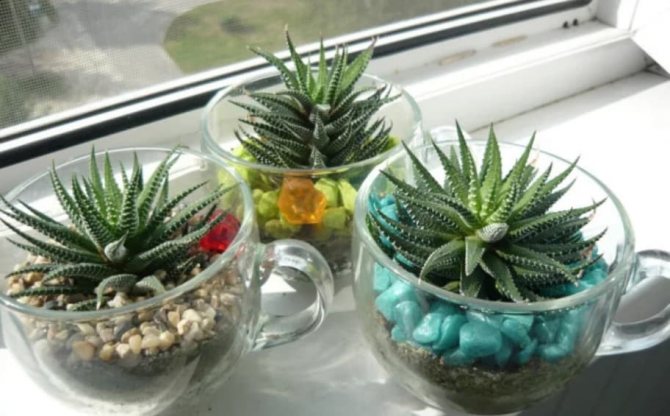

How to create a mix of succulents
Haworthia looks great with other succulents. A wide glass container is suitable for the basis of an unusual garden. It needs to be disinfected, fill the bottom with a layer of drainage. Priming:
- garden and leaf land;
- sand;
- activated carbon (protects against mold).
For decoration, you can add stones, artificial elements, etc. Carefully plant succulents in a pre-planned composition. Water a little, then moisten the soil about once a month.
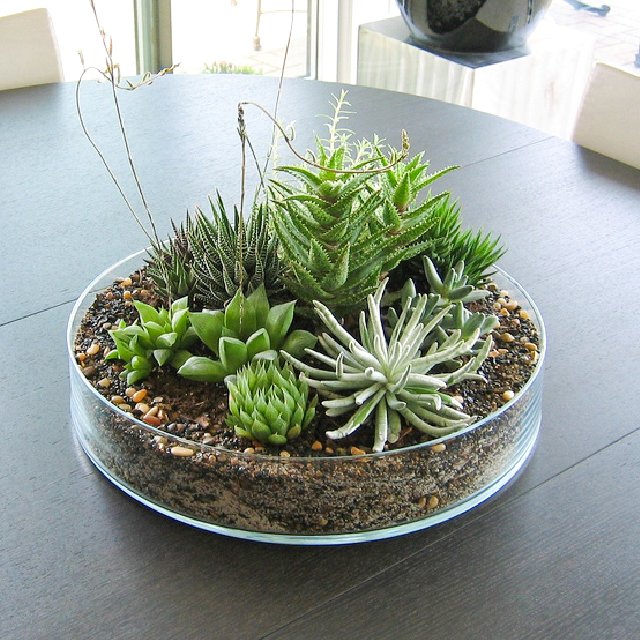

Succulents in an open florarium can become an unusual element of home decor.
Care errors and their elimination
Problems and solutions:
| Problem | The reasons | Elimination |
| Leaves turn yellow and dry | Lack of moisture for a long time. Excessive application of nitrogen fertilizers | Water the plant with fleshy leaves in time, but do not exceed the norm: rotting of greens and roots occurs. Apply fertilizers in the optimal amount, do not exceed the frequency of fertilizing |
| Rots | Boggy soil. Low room temperature: moisture does not have time to evaporate. The flower grower pours water directly onto the leaves: liquid accumulates in the root outlet and sinuses | Adjust watering according to the rules. Move the succulent flowerpot to a warmer room |
| Does not grow | Little light. Low temperature. Natural process (weak growth) | Haworthia is a slow growing species, and it is not always possible to determine how well a flower is developing if there are no clear signs of damage to the specimen. Sometimes only the flowering of the succulent confirms: everything is in order with the plant. |
| Leaves turn red | Exposure to the "direct" sun. The flower grower does not shade the succulent on the hottest days | Move the haworthia pot to an area where there is sometimes shade or provide shelter from the scorching sun if necessary |
| Leaf plates wrinkle | There are two options: excessive watering for a long time (3-4 months) or, conversely, a moisture deficit | Eliminate the factor that provoked a change in the appearance and density of fleshy leaves |
| The appearance of black spots and dots on greenery | Excessive watering. Poor drainage of liquid from the flowerpot | Increase the intervals between wetting the substrate. Check if flat stones are blocking drainage holes |
| The leaves are lethargic, not so voluminous, too "elongated" | The plant is in a draft or in a dark room | Rearrange the flowerpot (exclude the influence of a draft). Move the succulent pot to a bright, warm room. After two to three weeks, be sure to turn the container so that the light evenly hits all sides of the flower |
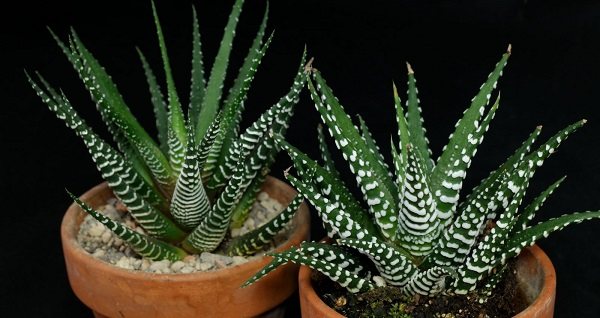

Watering
Better moisture will be a little short, than there will be an excess of it. It will be optimal to carry out the next watering of the Haworthia after the soil has dried from the previous one. This usually happens every 5-10 days, it all depends on the conditions of detention.
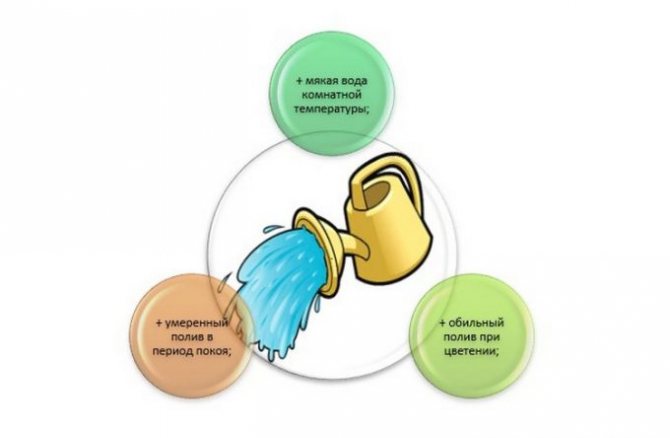

To prevent excess moisture from lingering in the pot, several holes. And pour out the liquid collected in the pan.
We take water for irrigation soft, at room temperature, having previously defended it. It is advisable not to tap water or pass it through a filter. This water has a negative effect on many varieties of Haworthia. When watering, make sure that no liquid gets on the leaves, especially in the middle of the outlet.
Possible difficulties in growing haworthia striped
Haworthia cannot be called a whimsical indoor flower; it is not uncommon for almost lifeless specimens to enter a new house, which, with proper care, manage to fully recover. Most often, these succulents suffer from the mistakes of the grower.
Care and maintenance errors
The following violations can seriously undermine the health of even such persistent and unpretentious plants as haworthia:
- weak lighting - the flower loses its decorative effect, the rosettes become loose, and the leaves lose their brightness;
- content of succulent in the sun - can lead to foliage burns and discoloration, green plates turn brownish;
- lack of nutrients - the tips of the leaves dry out, the growth of haworthia slows down;
- excess dressing - the foliage loses its turgor, becomes yellowish or reddish.
Most often, to help a green pet, it is enough to eliminate mistakes and continue not to make them. As for diseases, they are also in most cases the result of poor or inappropriate care.
It is interesting! Haworthia is considered a protective plant, an energetic, which spreads its positive energy in the house. And if a succulent begins to grow poorly, then it is actively fighting negative influences and it lacks strength for itself. Perhaps, if quarrels and conflicts in the family diminish, this baby will have more energy for growth and development.


1. Seven Secrets of Success:
| 1. Growing temperature: summer - 18 - 26 ° С, winter - it is advisable to provide Haworthia with a cool rest period at a temperature of 6 - 10 ° С. |
| 2. Lighting: brightly lit location, plants should sunbathe in the morning and evening daily. Light shading is possible only during especially hot daytime hours. |
| 3. Watering and humidity: irrigate with warm water during spring and summer in such a way as to dry out a layer of soil 2 - 3 cm thick between them.In autumn, watering is reduced and in winter they protect the soil from complete drying out. The air humidity is not increased. |
| 4. Features of the: Haworthia can be recommended for growing by novice growers as one of the most unpretentious plants to external conditions. |
| 5. Priming: Neutral or alkaline soil, can be a nutrient-poor substrate that is easily permeable to moisture and air and has excellent drainage. |
| 6. Top dressing: every 2 weeks with liquid mineral fertilizers for succulent plants in half the concentration in the warm season. In the fall, fertilizing is reduced and in winter the plants are immersed in a dormant period, refusing to fertilize the flower. |
| 7. Reproduction: separation of daughter rosettes during spring transplantation, leaf cuttings in spring and summer, by seed method. |
Botanical name: Haworthia.
Haworthia flower - family... Xantoreids.
Origin... South Africa.
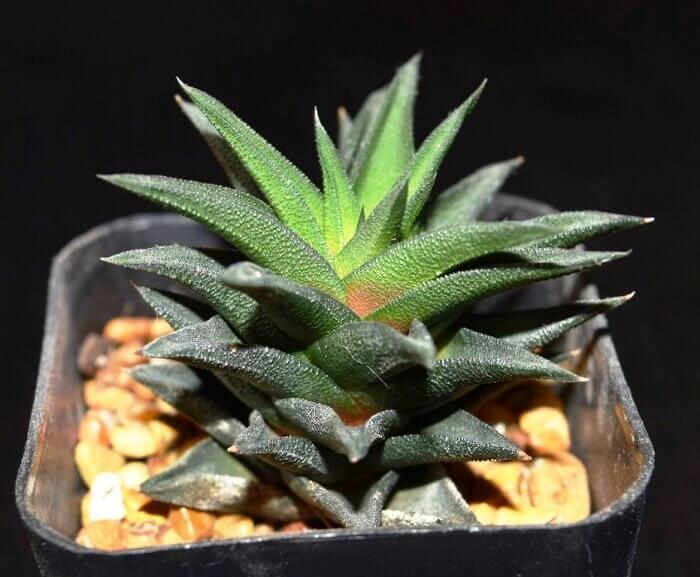

Description... Haworthia are low, evergreen succulent plants with an extremely varied appearance.
Haworthia form leaf rosettes sessile green, oblong-triangular, juicy leaves... Shades of leaves contain all tones of green, bluish-silvery with longitudinal and transverse stripes and spots. Some varieties have orange or red leaves with spines at the tips.
During the flowering period, high rosettes appear in the center of the rosette. peduncles, on the tops of which small inconspicuous flowers white or pink.
Plants of some varieties with age can form low stems.
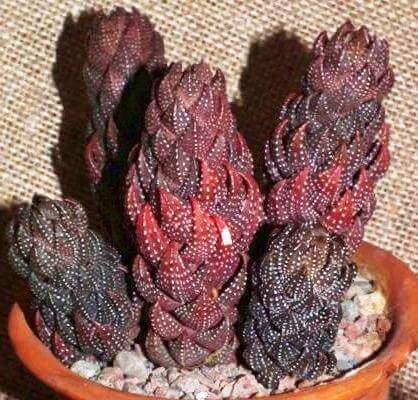

Height... Often does not exceed in height 5 - 30 cm., develops slowly.
The final plant size will depend on the variety, conditions and age of the flower.
In nature, some plants reach a height of 1 m, but this takes them several decades.
Breeding features
Haworthia cooperi is propagated by seeds, leaves or side shoots:
- Seed propagation takes place in the traditional way. The seeds are bought at a flower shop and planted. The growth process is quite long, it is often practiced by breeders.
- Lateral shoots (also called "babies") are separated from the mother's outlet and planted in a separate pot with a substrate. But only opaque sockets can be transplanted, since there is no chlorophyll in the transparent ones, and they are not ready for independent growth.
- The leaves are cut off, treated with ash or coal and "listened" for 2-3 days.
Possible difficulties and illnesses
Although Haworthia is considered an unpretentious crop, in some cases it can be exposed to diseases or pests. As a rule, this happens with improper plant care.
For example, if the roots or tips of the leaves dry out, this may indicate an increased moisture content in the substrate. In addition, the bush can grow crooked. This happens when it is unevenly lit. If you notice rotten or dark leaves, immediately revise your watering schedule, as your plant suffers from excessive moisture.
Of the pests, haworthia most often affect scale insects and mealybugs. If these insects are found, the leaves of the succulent should be washed with soapy water, and in case of mass damage, they should be treated with special insecticides.
You will find more detailed information about this amazing plant in the video.
Useful properties of Haworthia


It is believed that biologically active substances released into the air by Hawortia improve the air environment of the home. Therefore, the plant helps to reduce physical and mental fatigue.
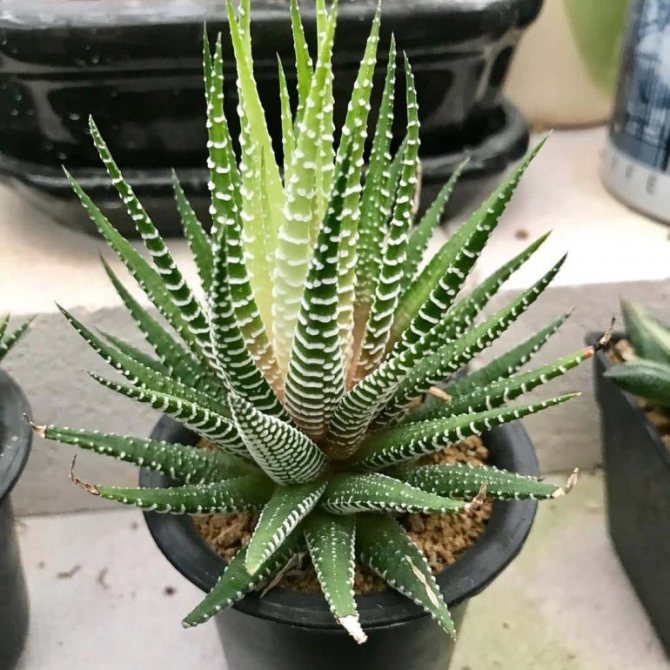

Haworthia is striped. Photo
What conditions are required depending on the season
At different times of the year, some canons should be adhered to.
| Lighting | Loves diffused light, can grow in partial shade. On the northern window sill, artificial illumination of the flower will be required, on the south side - shading. |
| Temperature | Optimal in summer - 20 degrees C, at higher modes, increase the amount of light. Winter -10-12 degrees S. |
| Humidity | There are no special requirements. In summer it is recommended to take it out to the balcony. |
| The soil | Succulent soil, fine gravel, broken shell rock, clay, sand (3: 2: 1: 3: 3). |
Deciduous bouquet
The stem of the plant is usually very short. As a rule, it is almost impossible to see it among the foliage.
The Haworthia flower is easily recognizable for its foliage. Fleshy and large leaves almost always completely encircle the stem of the plant almost from the base and form an extravagant green (sometimes mixed with other flowers) bouquet.
Depending on the species, the leaves can have sharp or blunt tips, stripes or specks of various colors. The surface of the leaf can be completely smooth or serrated, have tubercles, denticles, cilia and villi. In many species, leaf tops have transparent areas designed to better absorb sunlight.
However, there are also species in which only a few leaves are located on the stem, and quite distant from each other.
Haworthia flowers, on the other hand, are unremarkable. In almost all species, they are the same - small, white in color.
The root system is of several types:
- Well branched from fleshy fibrous roots. It is characteristic of the haworthia of the marginata group, which, by the way, grow easier and faster than the rest of their species.
- A small root system that stretches and retracts depending on moisture is characteristic of the retusa group.
- Not strongly developed root system in pillar-shaped haworthia. It is compensated by aerial roots.
Description
Haworthia (Haworthia) belong to the Asphodelaceae family, subfamily Asphodelicae. They are monocotyledonous plants, capable of flowering, belonging to the order Asparagales.
They are succulents: squat, medium-sized plants with fleshy, succulent leaves collected in an outlet. The leaves are rather fancifully structured, due to white tubercles or colorless transparent areas of the "windows".
There are stem species, but their stems are very short, they are almost invisible due to thick leaves closely spaced around a circle.
The plant blooms, as a rule, very inconspicuous, with white or indistinct greenish small flowers.
Haworthia came to us from South Africa. It has several of the same unusual names (Gavortia, Gavortia), and because of the similarity of some species with a bush, the scarlet plant is often called “dwarf scarlet”.
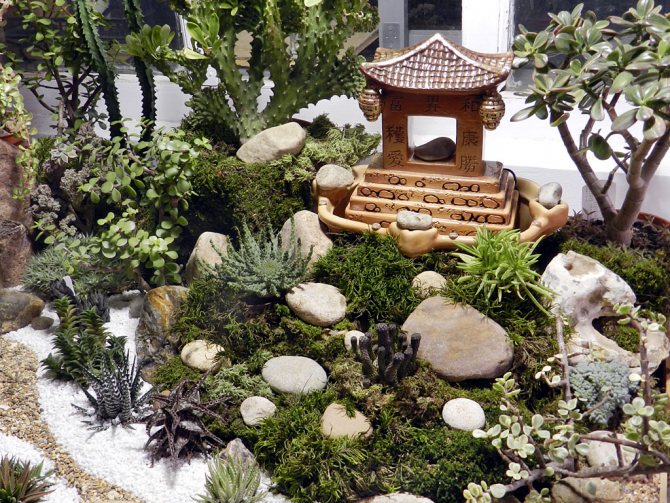

Biologists divide the Haworthia species into three subspecies, but the famous flower connoisseur Valery Zlotin believes that it is more correct to distinguish five groups:
1. "Aloe-like", which include such common species in our country as:
- chloracantha,
- cooperi,
- limifolia,
- fasciata,
- tesselata,
and also much more rare:
- koelmaniorum,
- pumila,
- marumiana, etc.
2. "Pillar-like" - H. reinwardtii, very popular among us, quite widely known H. armstrongii, H. coarctata, H. viscosa, as well as H. glauca and very rare H. nigra. These species have a low stem, tightly entwined in a spiral with fleshy leaves.
3. "Flat" - extremely beautiful plants with flat-cut ("dull") leaves, usually with transparent windows. In nature, these plants are often completely submerged in the soil, only flat areas of leaves come to the surface. In our collections, the most common H. truncata is a miniature masterpiece of nature. This plant does not have the shape of a rosette, but a fan, or an open book. H. retusa can also be found. However, we have almost unknown many beautiful views, such as:
- bayeri,
- comptoniana,
- emelyae,
- magnifica,
- maughanii,
- mirabilis,
- mutica,
- pygmea,
- springbokvlakensis, etc.
4. "Lacy" - with cilia along the edges of the leaves, giving the plants a lacy look. This group includes H. arachnoidea with many varieties, H. bolusii, H. decipiens, H. lockwoodii, H. xiphiophylla and some others. Unfortunately, these wonderful species are practically not found in our country.
5. The last group - "herbaceous" Haworthia, which include H. blackburniae, H. longiana and H. Wittebergensis. The leaves are long and thin. For example, in H. blackburniae, the leaves, with a diameter of 3-5 mm, reach a length of about 40 cm.
Features of keeping at home
Haworthia is unpretentious.Keeping and reproducing it at home is not particularly difficult. Even if you are a beginner gardener, and you simply do not have time to fully care for the plants, but you want to have them, Haworthia is exactly what you need. Observing simple rules, you will cope with the task.
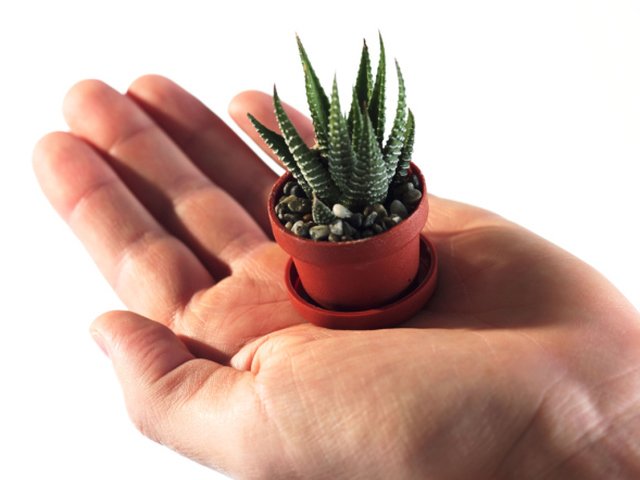

Even beginners can keep haworthia at home.
Popular varieties - table
| Name | Description of the plant |
| Haworthia pearl | Highly decorative appearance with lanceolate, upwardly thick and fleshy leaves, up to 7 cm long. The main color is dark green, against its background white growths, similar to pearls, stand out favorably. The inflorescence consists of small greenish flowers located on a peduncle 30 cm high. |
| Haworthia striped | The most popular species has lanceolate leaves growing from the root. Not very fleshy, but firm. They grow up to 10 cm in length. The color is dark green. The upper side of the leaf is smooth, while the underside has outgrowths forming a striped pattern. The peduncle is long, brown. Decorated with small white flowers. |
| Haworthia chess, or mosaic | Has no stem. The leaves are thick, triangular in shape, growing in a spiral. The lower side is convex, the upper side is flat. They reach a length of 3.5 cm. The apex is pointed, along the edge of the leaf there are small denticles. The color of the leaf plate is green, the surface is decorated with a white pattern resembling the cells of a checkerboard. Flowers of white-green color are collected in a small panicle. |
| Haworthia Big Band | The length of the leaves, narrow and fleshy, reaches 5–10 cm. The shape is linearly pointed. The color is dark green. The upper side of the leaf is monochromatic, the lower side is decorated with bright white specks forming a striped pattern. White inconspicuous flowers are located on a brown peduncle. The view is very decorative. |
| Haworthia lemon-leaved | Leaves in the shape of a wide triangle are tough and dense. Form a rosette 10 cm in diameter. Painted in dark green or yellow. The lower and upper sides of the leaf plate are covered with wavy growths, which are not found in other types of Haworthia. It blooms with small white flowers. |
| Haworthia Reinwardt | Small, thick, toothed leaves are very numerous and fit tightly around the stem. They grow vertically. The shape is lanceolate, the length of the leaf is 3.5 cm. The plant itself reaches a height of 15 cm. The underside of the leaf is covered with multiple growths, similar to warts, of bright white color. There are few of them on the upper side. The inflorescence consists of yellow-green flowers, collected in a raceme. The peduncle is long. |
| Haworthia elongated | Leaves are dense and wide. Forms a star-like rosette. There are transparent "windows" on the upper side of the sheet. |
| Haworthia Maugana | Leaves growing straight upward look like cylinders. The height is the same for all. The inflorescence resembles a brush of white-green color. |
| Haworthia cobweb | The processes located along the perimeter of the leaves are located close to each other and look like a cobweb. Sometimes this dense plexus resembles a ball covering the leaves. |
Such different haworthia in the photo
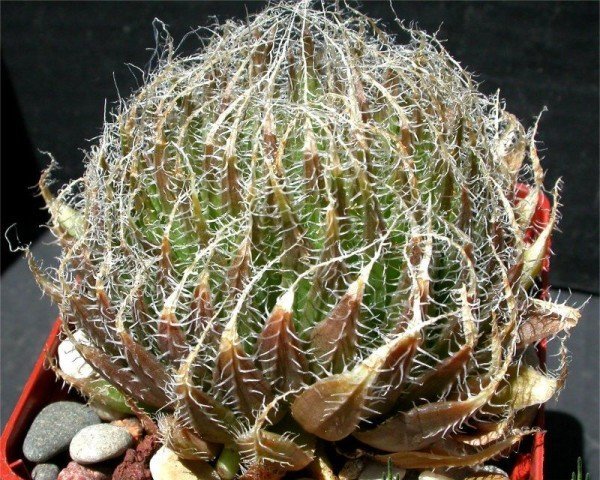

Haworthia cobweb
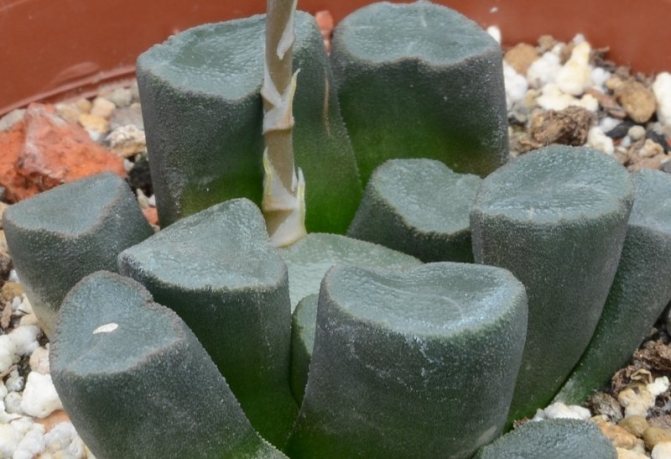

Haworthia Maugana


Haworthia elongated
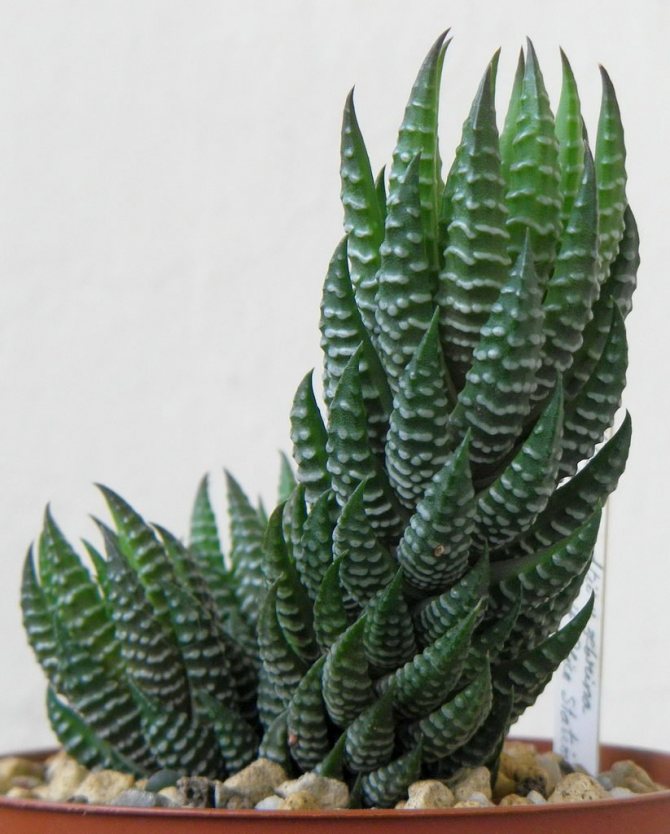

Haworthia Reinwaldt


Haworthia lemon-leaved


Haworthia Big Band
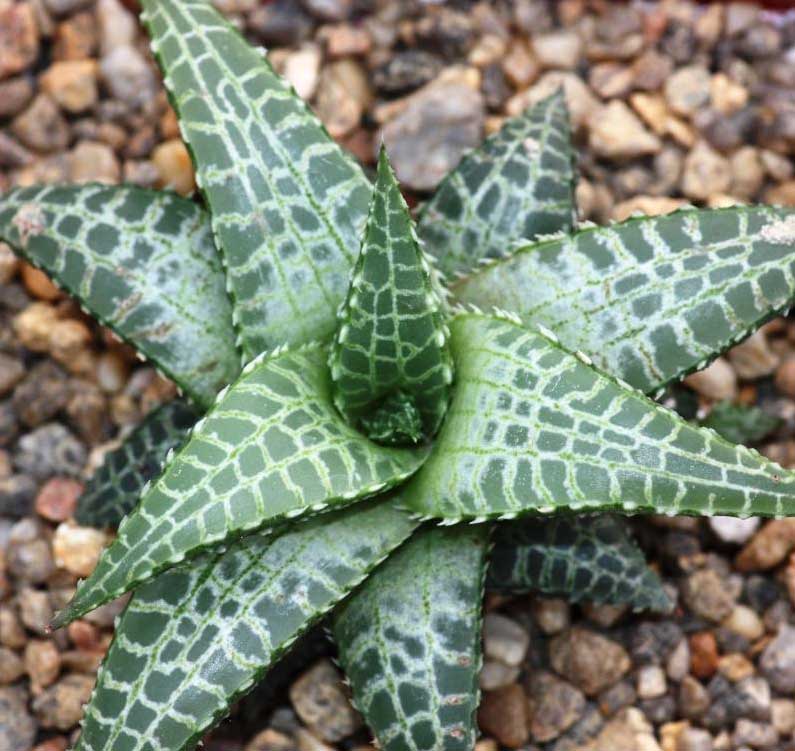

Haworthia chess, or mosaic


Haworthia striped
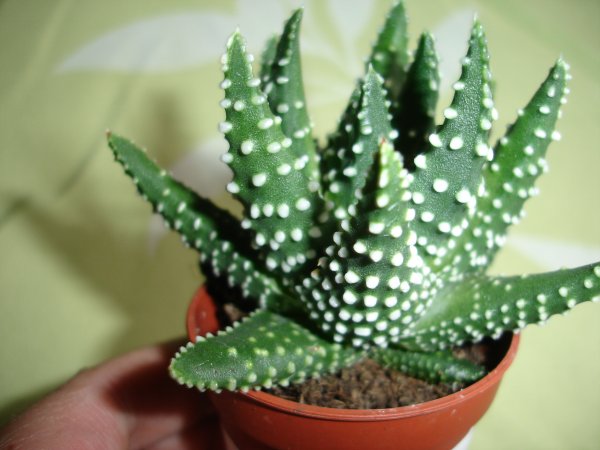

Haworthia pearl
Features of seasonal care - table
| Season | Lighting and location | Air humidity and soil | Temperature |
| Spring | Haworthia loves bright, but diffused light. It will feel good on the east or west window. The southern one is also suitable, but with shading at noon hours. In summer, it is good to take the plant out to the balcony, placing it in a light shade. Remember that haworthia must be protected from rain. The room in which the plant is kept must be well ventilated. After winter, Hawortia is gradually taught to sunlight. | Air humidity for Haworthia does not matter. But the soil moisture is high. On especially hot days, when the root system of the plant stops working, wet soil can lead to the death of the plant. In the summer, you can wipe the leaves with a smooth surface with a damp cloth, removing accumulated dust. | The optimum temperature for this period is + 20 ... + 25 ° С during the day. At night - not lower than +15 ° С. Haworthia can withstand short-term heat up to +40 ° C. But if the period of elevated temperatures drags on, the plant may fall into stagnation, that is, physiological hibernation. |
| Summer | |||
| Fall | In winter, the plant is not sprayed in any way. At low temperatures, the soil must be dry. | In order for the plant to pass the dormant period, the winter temperature must be lowered to + 5 ... + 10 ° С. At temperatures above +10 ° C, Haworthia will continue to grow, which, without enough light, will lead to a loss of decorativeness. | |
| Winter |
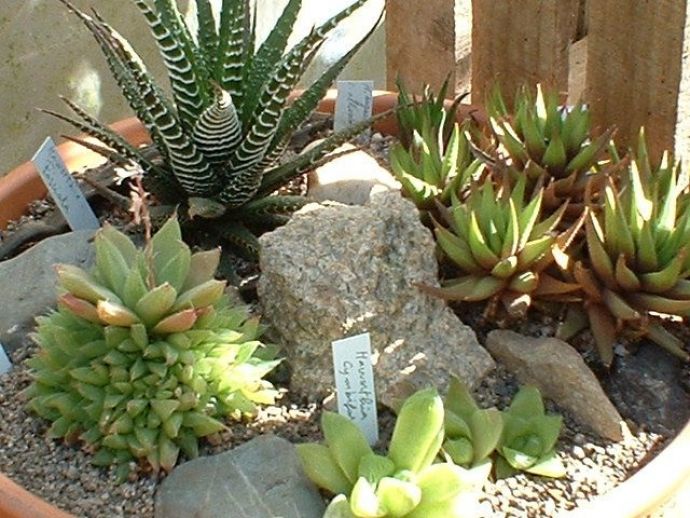

In summer, haworthia can be taken outside, shaded from the sun
Benefits and signs
The beneficial properties of haworthia lie in both protective and energetic abilities.
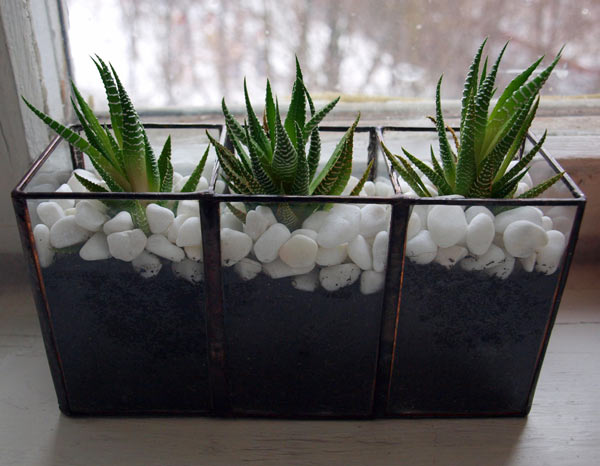

Signs say that the poor growth of a perennial demonstrates the return of a significant energy flow to combat negative effects: the succulent has no strength left on its own development. The flower is ideal for decorating a workplace, kitchen: it gives energy, increases work and mental activity.
Caution! It is not recommended to install the flower in the bedroom and nursery.
So, sometimes the exotic Haworthia flower scares indoor plant lovers with demanding care. However, he is not capricious and is well adapted to the apartment environment. It takes a lot of effort to destroy the plant.

